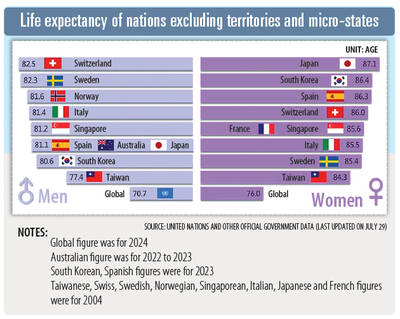The Taipei Mass Rapid Transit (MRT) has operated at a loss every year since it opened in 1996, but could balance its books with an average fare hike of just NT$0.5 (US$0.02), a Taipei Rapid Transit Corp representative said.
The Taipei MRT has failed to generate a profit, despite increasing passenger numbers, Taipei Rapid Transit Corp planning division director Wu Chun-yo (吳俊佑) said.
“That branch of the corporation loses money every year, it is just a matter of by how much,” he said.
In bad years the MRT runs up a deficit of between NT$700 million and NT$800 million, he said.
However, the company last year posted a NT$300 million deficit, the lowest in its history, because it took steps to boost passenger numbers on weekends, Wu said.
“We rolled out single-day passes for families and groups, and deals were struck with Taipei 101 and businesses in the Yongkang Road (永康) area to give gifts to tourists using the single-day pass,” Wu said. “Those measures have increased ridership and therefore fare revenue.”
“After [Taipei] Mayor Ko Wen-je (柯文哲) took office, he demanded that the operational efficiency of the MRT be maximized to offset losses in transit operations,” he said.
The MRT last year branched out its business operations, including initiatives to rent office space at its stations, Wu said.
Rent from office space generated revenue of NT$68 million and rent from online vendor Catch Power Co’s merchandize retrieval boxes — located in 108 MRT stations — generated another NT$15 million, he said.
The expansion of commercial space in MRT stations was followed by an increase in the number of visitors, resulting in greater opportunities for paid advertisement, Wu said.
Business operations peripheral to urban transit has more than made up for the deficit that transit operations have incurred, with the company’s bottom line having risen from NT$500 million in 2015 to NT$1.5 billion last year, he said.
“When the then-Muzha (木柵) Line opened in 1996 it was the MRT’s only service and it had a daily ridership of 30,000 people. Now the urban transit network has a daily ridership of 2.03 million,” Wu said.
“The chronic deficit in the transit arm is caused by the need to set aside funds every year in anticipation of buying new carriages,” he said.
“The Taipei MRT services also differ significantly from those in New Taipei City in terms of profitability, with most of the revenue-generating lines in Taipei passing through places where businesses sustain traffic,” he said.
In contrast, New Taipei City lines tend to make less money or operate at a loss, such as the Blue Line section that goes to Tucheng District (土城), Wu said.
Total ridership in the Taipei MRT was 730 million last year, Wu said, adding that a small increase in minimum fares — from NT$23 to a hypothetical NT$23.5 — would be sufficient for the transit arm to turn a profit.
However, the Taipei City Government has no plans to hike ticket prices in the short term due to policy concerns, Wu said.

Eight restaurants in Taiwan yesterday secured a one-star rating from the Michelin Guide Taiwan for the first time, while three one-star restaurants from last year’s edition were promoted to two stars. Forty-three restaurants were awarded one star this year, including 34 in Taipei, five in Taichung and four in Kaohsiung. Hosu (好嶼), Chuan Ya (川雅), Sushi Kajin (鮨嘉仁), aMaze (心宴), La Vie by Thomas Buhner, Yuan Yi (元一) and Frassi in Taipei and Front House (方蒔) in Kaohsiung received a one-star rating for the first time. Hosu is known for innovative Taiwanese dishes, while Chuan Ya serves Sichuan cuisine and aMaze specializes

STATS: Taiwan’s average life expectancy of 80.77 years was lower than that of Japan, Singapore and South Korea, but higher than in China, Malaysia and Indonesia Taiwan’s average life expectancy last year increased to 80.77 years, but was still not back to its pre-COVID-19 pandemic peak of 81.32 years in 2020, the Ministry of the Interior said yesterday. The average life expectancy last year increased the 0.54 years from 2023, the ministry said in a statement. For men and women, the average life expectancy last year was 77.42 years and 84.30 years respectively, up 0.48 years and 0.56 years from the previous year. Taiwan’s average life expectancy peaked at 81.32 years in 2020, as the nation was relatively unaffected by the pandemic that year. The metric

Taiwan High Speed Rail Corp. (THSRC) plans to ease strained capacity during peak hours by introducing new fare rules restricting passengers traveling without reserved seats in 2026, company Chairman Shih Che (史哲) said Wednesday. THSRC needs to tackle its capacity issue because there have been several occasions where passengers holding tickets with reserved seats did not make it onto their train in stations packed with individuals traveling without a reserved seat, Shih told reporters in a joint interview in Taipei. Non-reserved seats allow travelers maximum flexibility, but it has led to issues relating to quality of service and safety concerns, especially during

A magnitude 5.1 earthquake struck Chiayi County at 4:37pm today, the Central Weather Administration (CWA) said. The hypocenter was 36.3km southeast of Chiayi County Hall at a depth of 10.4km, CWA data showed. There were no immediate reports of damage resulting from the quake. The intensity of the quake, which gauges the actual effect of a seismic event, measured 4 in Chiayi County, Tainan and Kaohsiung on Taiwan's seven-tier intensity scale, the data showed. The quake had an intensity of 3 in Chiayi City and Yunlin County, while it was measured as 2 in Pingtung, Taitung, Hualien, Changhua, Nantou and Penghu counties, the data